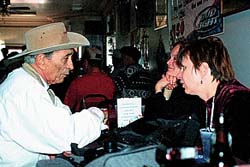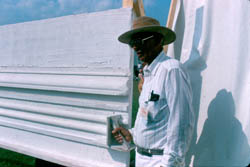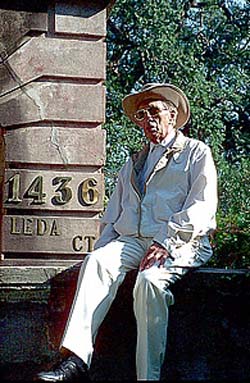
Table of Contents
Introduction: The New Orleans Building Arts Project
Builder's Voices
Brick Masonry
Carpentry
Ironworking and Blacksmithing
Tile Masonry and Painting
Plastering
Shoring, Plant & Maintenance Engineering
Wood Crafting
How the Seventh Ward Was Built
Labor Day

Earl Barthé (Plasterer)
My great grandfather, Leon Barthé, he hailed from a little place they call Nice, France. It's on the Mediterranean just across from Italy. That's where Nice is. A lot of plasterers and Barthés [live] there today. But he left in the early 1800s, and he decided that he was coming to America. But before he arrived, he stopped off in Haiti and that's where he met my grandmother. And he brought her over to New Orleans with him. . . . And he was a master plasterer. My daddy told me that old man Leon could look at you and produce you in plaster as he's looking. No sketches, no drawings, anything. That's the type of mechanic that he was.
My daddy [taught me]! You had to mix the plaster; that was the first thing. Then I'd pick up the tools to put it on the wall. My dad would say, "Son, come over and get this." I thought he was the meanest man in the world; he would not let me work on the wall and put it on! It was his strategy—he wanted me to want to work so bad, and get on that wall so bad, that when I'd get there, he knew I was going to be good. . . . It was just like race horses. Each family was trying to produce the best. . . . The fathers would watch you work and give you suggestions and short-cuts because they wanted their sons to be the best.
My father and grandfather trained us right from the jump, trained us to appreciate this work. You cannot do this work if you don't appreciate it. It's not something you're just doing out of the sky. It's some precious work. It's like a diamond, like a jewel, and it's for you to preserve it. And I can remember being a young man, they'd have all of us young bucks working and my dad would tell me, "Boy you don't know nothing. Tito's son is way better than you." And Tito, he'd tell his son I'm way better than him. The idea [is] to get us working. And they would put us on fine work, articular work, and our fingers and hands had to be conditioned to do that.

The fine work is the ornamental work, the cornice work. Medallions, and medallions in the ceilings, and the corbels in the arches—that's the bottom of the arch, that "L"—looking thing on the bottom of the arch. So they would be watching us to see that we would do that work, to reproduce it exactly like what it was.Or even if we running a new section in another part of the house, them old people would go in there and take readings. Like, when I say a reading, they would go in there and cut that cornice and trace it to be sure we were doing the same thing on the upper and lower floors. And that was very important to them. They didn't just want a plasterer, they wanted a master craftsman. And New Orleans, you know we produce some of the best. All due respect to New York—New York has some good plasterers, California has some good ones—but they, even in New York and California, will tell you New Orleans produced the best mechanics.

[Working in plaster] is just like music and it all have to been in tune. So when you run your arch, you gotta put your corbel on the bottom. That's like the big bass. It look like a bass. And that have to go on the bottom. So, the musicians [in a crew], they're more in tune with that, . . . they had that touch, a musical touch. And they would sing when they'd be putting these dentils in fillers. They would be setting the dentils into that cornice and they'll be singing the songs of Muddy Waters and all these songs; they'd be singing and be placing the dentils and ornaments into this cornice.



